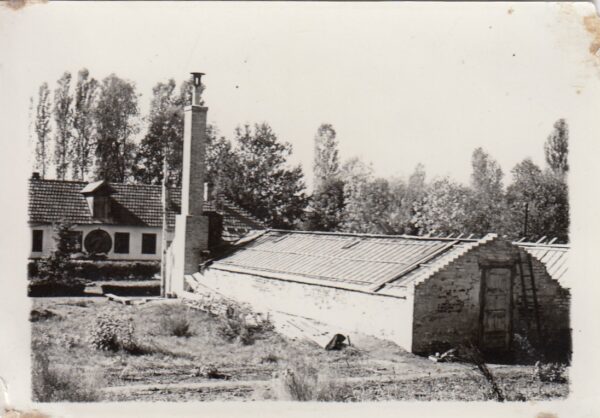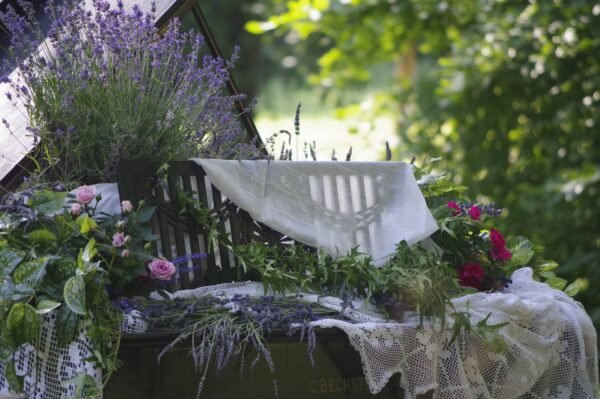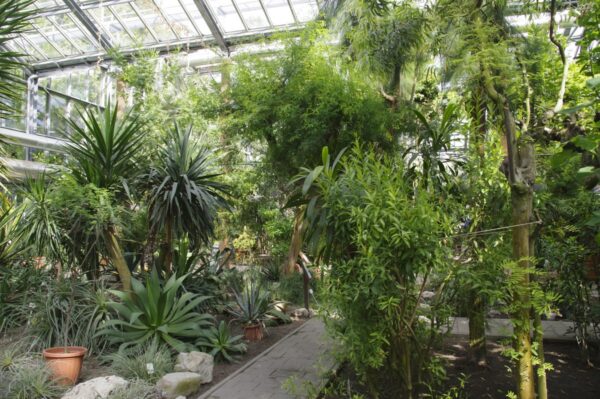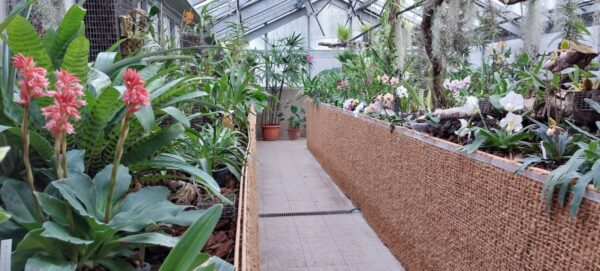The history of the Botanical Garden of the University of Szeged
When the University of Cluj-Napoca moved to Szeged in 1922, the city donated 20 cadastral acres of arable land to the university for the purpose of establishing a herb garden. The establishment with plants is carried out by the founding director, István Győrffy He started in 1925, using material from collecting roads. In 1928, the Ártéz well was established, in 1929-30 a greenhouse for growing plants, and in 1931 the first lake was completed.

In the same year, the first seed exchange catalog (Index Seminum) was published. In 1932, the Indian lotus came to Szeged from the lake of the Návay castle in Óföldeák-Gencshát, which has been a special attraction of the garden ever since.

from 1940 Pál Greguss professor held the position of director. He is credited with the creation of the didactic collections of the garden at that time (rose garden, rock garden, arboretum, taxonomic collection) and the introduction of the ancient Szechuan (southern Chinese) pine. Between 1952-58, he had greenhouses built to display tropical crops.

from 1965 Imre Horváth professor took over the position of director of the garden. He expanded the area of the garden by 10 cadastral acres. Instead of the usual taxonomical plant presentation in herb gardens, he created plant communities – the first in Hungary.

He realized that, in addition to education, the herb garden should also perform research tasks, and built the phytotron building suitable for conducting autoecological research. In addition, he expanded the greenhouses with three houses covered with foil in the winter, developed central heating, paved roads and street lighting, and introduced city piped water.

For three years after the death of Professor Horváth Pál Simoncsics, then Sándor Gulyás managed the Herb Garden. At that time, the renovation of the rose garden began, and the collection of perennial plants was created.


In 1992, on the 70th anniversary of the garden's existence, Sándor Gulyás had the ornate Székely gate of the entrance erected.

From 1996 to 2013 Erzsébet Mihalik performed the duties of director. During this time, following the ever-expanding requirements for herb gardens, Aniko Németh (current director) and with the help of his colleagues, new activities were started and are still ongoing.
From 2006, flowering and reproductive biology research was started with the inclusion of protected plant species, the spring heather and the Siberian rose petal. The Botanical Garden in Szeged was one of the first to recognize the importance of ex situ plant propagation and successfully participated in a LIFE application establishing the foundation for the long-term protection of carnations. In the process, 15,000 long-lasting carnations were propagated and planted back in their natural habitat. The tender started in 2006 and lasted for 5 years.
For the first time in the country, environmental education also appeared on the garden's range of services. We offer thematic sessions for preschool and school groups in all seasons, and interested children can get to know the flora in the Summer Horticulture Camp. In addition to young people, the garden is also open to city dwellers and families. With our events related to significant days (Earth Day, Bird and Tree Day), our aim is to present the diversity of plants and the values inherent in them on a wider scale.
Collection development continued in 2007. The farmyard has been created, where we present the typical vegetables and ornamental plants of the farm world around Szeged. The drinking fountains were also renovated.
We organized the Lotus Days for the first time in 2008. The two-day family event was timed for the plant's peak flowering period, at the end of July.
In 2009, a diorama showing the bird life of the Botanical Garden was built. Information boards and games related to flora have been placed at many points in the garden.
In 2010, the plant propagation house and the phytotron building were renovated with the help of tenders, and a modern plant breeding light chamber was created inside. The cleaning dredging of the canal and lake system also took place.
In 2011, the herb and spice garden, designed on the model of former monastery gardens, was handed over. Even this year, the cultivated plant display got a new, inviting look, where those interested can get to know exotic food plants, oil, fiber and dye plants. The washrooms were modernized and a toilet for the disabled was created.

By the fall of 2012, the houses covered with foil in the winter were converted into greenhouses. At that time, most of the fence around the garden was renovated. The first element of the playground arrived in the spring of 2012.
In 2013, the range of attractions was expanded with the renovation of the bird-friendly garden, as well as a butterfly-friendly garden and beekeeping demonstration. The playground was further expanded. This year saw the start of the EU project of the new tropical greenhouse worth more than HUF 250 million, which was built on the site of the old facility.
As of July 2013 Aniko Németh performs the duties of the director of the Botanical Garden, who in previous years, not only as deputy director, but also as a researcher, event organizer and institutional contact person, took on an important role in the operation of the Botanical Garden.

The new one was handed over on April 26, 2014, at the Earth Day event tropical greenhouse, which is now decorated with plants and welcomes visitors every day of the year. In the greenhouse with a floor area of more than 500 square meters and an interior height of at least 7.5 meters, most of the 50-year-old plants remained in place, but the showroom was expanded with many visual elements. In and around the newly built, multi-level lake system, you can see aquatic and waterside plants of tropical rivers and lakes: fairy roses, papyrus sedge, water hyacinth. Insect-catching plants, pitcher plants, and hornworts were also housed in this greenhouse. From the gallery running around the edge of the greenhouse, you can admire the tropical collection from a completely different perspective, almost from the height of the canopy.
Those interested can get to know the plant material of the collection by grouping it around different topics (useful plants, rainforest plants, forms of plant adaptation, orchids, endangered plant species), so they are guaranteed to learn many interesting things about the striking diversity of tropical landscapes. Information boards help you find your way around and gain knowledge. Thanks to this investment, it cannot be visited until now due to lack of space our cactus collection also opened to the public. Among the more than half a hundred succulent, drought-adapted plant species, there are cacti with different forms and growth characteristics (e.g. tree-dwelling Rhipsalis), succulents (rose bushes, dogwoods) can be seen in a display area inside the greenhouse building.
In 2014, we organized for the first time the Lavender Days our event, the theme of which was inspired by the lavender collection in the garden, and the creation of the Japanese garden began.

In the year 2015, the Japanese garden design, the expansion of Asian plant material continued, so bamboos, camellias, rhododendrons, ornamental cherries, and female petals took their place. Starting this year, the entrance to the Japanese pedestrian garden will also be decorated with a torii Japanese gate. THE rock garden during its reconstruction, nearly 100 tons of andesite were installed and a related gorge fed by a waterfall was also completed. The rose garden historical roses added to his collection. As a donation from the National Botanical Garden, the collection of perennial plants has grown with many species. The surroundings of the farmyard are planted with fruit trees and a grape collection colored by its design. The reconstruction of the arboretum began, one of the endowments of which was the enrichment of the garden's dendrological collection with numerous plant species.
It was opened in May 2016 our tropical butterfly garden can be considered the number one attraction of the year. We managed to raise more than 20 tropical butterfly species and present them to those interested in a foil tent imitating the rainforest climate and vegetation. Connected to the butterfly garden, it is not open to the public until now collection of fernsis also open to the public. The ordinary amber presenting more than 30 letter variants variety collection was established, the species stock of the arboretum and greenhouses continued to grow. During the fall, more than 3,000 species and varieties of bulbous plants, special tulips, daffodils, saffron, lily-of-the-valley and autumn cypress were planted in the ground to color the beds with their flowers from the spring of 2017.
In addition to innovations, 2017 was also a year of evaluations and reviews, which the X. Lotus Days gave. The success of the event proved that we can draw attention to the importance of flora through family events that move a larger crowd. On the occasion of the anniversary commemorative medalmel, we rewarded those entertainers and helpers who raised the standard of the event with their dedicated work over the years. In view of the great interest, we opened the tropical butterfly garden this year as well. As a research program, on behalf of the Körös-Maros National Park, a plant propagation work lasting 5 years, until 2021, began during the summer, in which we undertook the collection of seeds of 83 rare, endangered or currently protected loess grass species in the area, ex situ (botanical garden) propagation, and then its replanting on wastelands in the initial stages of regeneration, thus promoting the preservation of natural plant diversity. It took place beekeeping demonstration expansion, and debuted as a new autumn event Mushroom day, in which we drew attention to this special group of organisms. We were pleased to see that our developments and programs were not without interest, as in 2017 we had a record number of more than thirty thousand visitors.
Among the events of 2018, as an innovation, a of a collection of insect-catching plants its design deserves mention, which is located on the floor of the tropical greenhouse. The collection presents the species and horticultural varieties of hornworts, pitcher plants, dew grasses, and sedges, a total of 59 taxa. In connection with this, in autumn we organized for the first time a professional and family day Insect Catching Plants Day.
Completed the renovation of rock garden. The replanted collection is currently home to 350 species and varieties of bulbous and perennial plants, including species and horticultural versions of botanical tulips, starflowers, crow's feet, thymes, poppies, flame flowers, and heathers. The rocky roofs are decorated with evergreens, 12 types of pine: dwarfed versions of forest and black pine and dwarf pine varieties were replaced. In the gorge with a waterfall between the rocks, the representatives of the ferns (stem fern, lady's fern, golden curlew, western scale fern) found their living conditions.

The raised beds that form the basis of the new systematic collection have been completed.
In the framework of joint research with the Körös-Maros National Park, in the autumn period we successfully resettled a total of 9,867 individuals of the 46 species that we have ex situ (raised in the Herb Garden) in the three larger territorial units of the national park. In addition to resettlement, we also planted seeds of 30 species on the sites.
In March, we started the year 2019 with 5 suitable courses presenting the basics of gardening, consisting of practical and theoretical parts. THE Let's garden together in the herb garden! its topics included composting, growing balcony plants, garden design, plant protection.
THE Plants Day our range of thematic programs has been expanded with an event. In recent years, we have participated several times in the International Plant Day program series held at various locations in the city, but this year, for the first time, the Botanical Garden hosted the event. On this occasion, university departments, research workshops and associations dealing with the scientific and educational promotion of flora were also invited and given the opportunity to present their activities to a larger audience.
It started Mediterranean greenhouse revision of his plant collection, during which the display was not only rejuvenated, but also expanded with several new species: the passionflower growing on the supporting columns with colorful and uniquely shaped flowers (Passiflora sp.) with species and horticultural varieties, temperate orchids and desert roses (Adenium sp.) with his collection. Connected to the entrance of the Mediterranean house, we also created a plant complex consisting of winter-resistant succulent species (yuccas, bear's paw cacti).

Unfortunately, the September storm that severely affected Szeged caused great damage to the plants of the Botanical Garden, especially the woody ones, several poplars, oaks, beeches and lindens fell or were severely damaged. The period at the end of the year was thus spent restoring the storm damage.
The joint project with the Körös-Maros National Park aimed at restoring abandoned fields continued. During the autumn period, we planted 11,082 individuals of 54 plant species propagated and raised by us ex situ, i.e. in the Botanical Garden, in 6 areas. In addition to resettlement, we also planted seeds of 36 species on the sites.
The garden was gratifyingly visited by many people, we had forty-four thousand visitors during the year.
In 2020, unfortunately, the epidemiological situation was the determinant of our operation. The garden was closed in the spring, and after the summer opening, we continued the work behind closed doors again in the fall. Taking advantage of the forced closure, we devoted our time and energy to the maintenance and development of the collections.
We designed one orchid houseat, in which, on the one hand, greenhouse orchids already in our collection were accommodated, and on the other hand, new acquisitions were also made. During the expansion of the collection, we placed great emphasis on the acquisition and presentation of naturally occurring (botanical species). The orchid house was located in the greenhouse next to the fern house. The collection contains 250-300 plants, nearly 90 species and 70 hybrids of 60 genera, both tree-dwelling (epiphytic) and soil-dwelling orchids.

The systematic collection, we planted plants, primarily domestic species, in the raised beds based on the latest taxonomic research. In the first five plots, we present nearly 250 species of dicotyledons, and in the last bed we present monocotyledons. Unique ceramics made by ceramist István Zakar were placed in front of the beds.

The Japanese garden has also been renovated at several points, a new tori gate has been built for its entrance and the display has been expanded with plantings.
The joint project with the Körös-Maros National Park aimed at restoring abandoned fields has reached its last year, covering the entire vegetation period. After seed collection and ex situ propagation, we successfully planted 10,399 individuals of 70 species on 6 regenerating fallows in the fall. The seed sowing and seed scattering affected three fallow areas, and we spread a total of more than 130,000 seeds on them.
Due to the increasing number of visitors over the years, the time was ripe for the construction of a larger ticket office building, separate from the main building. Construction work on the cash register started at the end of the year. Despite the restrictions, our annual number of visitors was favorable, with nearly forty-four thousand people visiting the Botanical Garden.
By the spring of 2021, we have completed two visitor-friendly investments to fill the gap: the new cashier building was completed and the garden's asphalt paths were renewed for nearly a kilometer. Unfortunately, the epidemic situation left its mark on this year as well. The garden did not have to be closed, but due to the restrictions, we were able to accommodate much fewer groups. The flora was burdened by the extremely hot and dry summer. Also for visitors as a new collection in connection with the tropical butterfly house opened the completely renovated Orchid house. A series of tables presenting the history of systematization was completed in addition to the systematic collection. The development of the existing collections also continued, the butterfly house and the orchid house were humidified, the rock garden collection continued to grow, and the Japanese garden was enriched with many species of plants, lanterns, and rocks.
Our joint restoration tender with the Körös-Maros National Park has come to an end. The last planting was also successfully carried out on the loess lawn of Tompapuszta, we planted 504 ex situ propagated seedlings. Thus, it can be said that during the five years of the project, we planted a total of 31,745 plants and collected more than 540,000 seeds from the 83 plant species agreed in the contract.
The Botanical Garden proved to be a popular destination again this year, with nearly forty-three thousand people curious about the university's green island.
In 2022, for the existence of the university Botanical Garden hundredth anniversary celebrated, in connection with which the series of our annual events was expanded with the centenary programs. Our visitors who like and gladly support the Botanical Garden were able to adopt a hundred plants during the year. Our award-winning program was the Day of Plants. In its entirety the rose garden was renewed, new varieties of roses were added to the beds, the central rose hut got a new roof and a pergola system was built next to the roads.

The rose garden is a One hundred years, one hundred photos became a worthy location for our nature photography exhibition. In October, we celebrated the Füvészkert's 100th birthday with a birthday cake, greetings, and a family day program. Former employees of the garden were also invited to the occasion. We especially thanked the work of our guests of honor, the predecessors who played an important role in the design of the garden. On the occasion of the centenary, a new garden was created with the title "Hundred years of Szeged University Botanical Garden" gardening publication.
The outdated skylights of the Mediterranean greenhouse were also replaced. The reconstruction of the outdated, accident-prone warehouse buildings has begun.
Our number of visitors also increased in the year of the centenary, forty-six thousand visited the Botanical Garden.





 Foundation for the Szeged Botanical Garden
Foundation for the Szeged Botanical Garden The media regularly reports on our events and developments. We collect them here…
The media regularly reports on our events and developments. We collect them here… You can read about our events by clicking on the link
You can read about our events by clicking on the link We haven't deleted our older articles either, take a look in our archive.
We haven't deleted our older articles either, take a look in our archive.